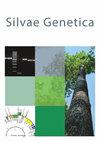地理上健壮的杨树杂交无性系的发现
IF 1
4区 农林科学
Q3 FORESTRY
引用次数: 6
摘要
摘要对美国明尼苏达州(MN)、印第安纳州(in)、密歇根州(MI)和纽约州(NY) 4个州(地区)的杂交杨树无性系生长进行了分析,发现了10个地理健壮性(地理健壮性)无性系,这些无性系均为P. deltoides x P. nigra (D x N)杂交种,它们分别在9度和20度的纬向和纵向范围内广泛适应。克隆效应对生长的解释占总变异的25 ~ 36%,是克隆与位点互作的2.5 ~ 4.1倍。克隆解释了两个部位发生溃疡病的总变异的24%至46%。计算了相对于商业检验克隆的生长遗传增益。地强无性系的生长遗传增益比随机无性系高24% ~ 44%。在MN位点上,各位点上的最佳克隆和地理健壮克隆的遗传增益差异不显著,但最佳克隆的遗传增益比其他位点上的最佳克隆高10% ~ 39%。除了MI站点之外,地理健壮克隆的增长速度都快于商业支票克隆。由于使用广泛适应的无性系而不是最佳无性系而导致的生长遗传增益的减少,必须与多个育种区的额外成本和收益进行比较。本文章由计算机程序翻译,如有差异,请以英文原文为准。
Discovery of Geographically Robust Hybrid Poplar Clones
Abstract Hybrid poplar clonal growth in the states (regions) of Minnesota (MN), Indiana (IN), Michigan (MI), and New York (NY) USA was analyzed to discover 10 geographically robust (geo-robust) clones, all P. deltoides x P. nigra (D x N) hybrids previously tested and screened in MN, that were broadly adapted across latitudinal and longitudinal ranges of 9 and 20 degrees, respectively. The clonal effect for growth explained 25 to 36 % of the total variance, 2.5–4.1 times the clone x site interaction. Clone explained 24 to 46 % of total variation in canker occurrence on two sites. Genetic gain in growth was calculated relative to commercial check clones. Genetic gain in growth of geo-robust clones exceeded that of random clones by 24 to 44 %. Geo-robust clones and the best clones on each site were not significantly different on the MN sites, but best clones outperformed geo-robust clones on the other sites by 10 to 39 % genetic gain. Geo-robust clones grew faster than commercial check clones on all but the MI site. The reduction in genetic gain for growth due to using broadly adapted clones relative to the best clones has to be compared to the additional costs and benefits of multiple breeding zones.
求助全文
通过发布文献求助,成功后即可免费获取论文全文。
去求助
来源期刊

Silvae Genetica
农林科学-林学
CiteScore
2.20
自引率
10.00%
发文量
10
审稿时长
3 months
期刊介绍:
Silvae Genetica is an international peer reviewed journal with more than 65 year tradition and experience in all fields of theoretical and applied Forest Genetics and Tree breeding. It continues "Zeitschrift für Forstgenetik und Forstpflanzenzüchtung" (Journal of Forest Genetics and Forest Tree Breeding) founded by W. LANGNER in 1951.
 求助内容:
求助内容: 应助结果提醒方式:
应助结果提醒方式:


